Kájovská No. 66
Description of the Building:
A one-storey house with a right and left court wing. The broken
front of the building originates from the mid 18th century while
elements of older renovation style were used (hood mouldings and
moulded window frames). A false attic floor was built with a
rectangular gable, finished with volutes. The layout of the ground
and first floors creates a lateral two-aisle. The front aisle has
flat ceilings on both floors while the rear aisle, which is not as
deep, has barrel vaults on the ground and the first floors. The
building has a saddle roof, finished in the direction of the yard
with a keel with the original, probably Rennaissance construction
of the roof truss.
Architectural and Historical Development:
The building does not seem to be of homogenous origin, probably
built on a place of an older house. In the Rennaissance period two
aisles of different depth were created. The layout of the house was
changed in 1874 when the right court wing was added. The
disposition and the renovation of the facade originates from the
period of Classicism.
Development of facade:
Only a rough-smoothen plaster layer appeared in fragments from the
Middle Ages. There were not any plaster discoveries from the
Renaissance period. Stone jambs at the first-floor level may have
been fixed in during that period. The facade was newly adapted in
the Classicism phase. The whole front was articulated with flat
pilasters finished by cordon ledges. Window holes at the
first-floor level are articulated with band shams, older above-
window ledges and window-ledges fillings with palm leaves all over
the sides. Window-ledge sets of small bars decorate the windows at
the second-floor level.

|

|
Only some pilasters, volutes with a triangle-shape extension
articulate the gable. The ground floor was adapted by band
rustic-work. The oldest coloured articulation: red-and-white. The
present ground floor fillings were installed during the restoration
of courtyard wing in the second half of 19th century and the ground
floor rustic-work disappeared. It is the first facade in a town of
Cesky Krumlov where the preservation method was used in 1996. The
facade was not even covered with the new unified paint. Only some
plaster retouching was done. Some older coats of paint can still be
seen on large facade surfaces. The only defect of it is an unreal
scheme of the parterre done by ashlaring.
 History of the House
Residents:
History of the House
Residents:
The first known owner of the house was Pavel Komínek, mentioned
there in 1513. After his death the house was inherited by his wife
Kateřina, who sold it to Bastl Brymbur, who was a town councillor
in the 1520s and the 30s. In the 1540s and 50s the house belonged
to Pavel Štětka, who also held the post of a town councillor. After
his death the house was obtained by his family and the widow
Barbora remarried. In the 1590s the house was bought by a manorial
burgrave Jan Louta. In 1620 Louta´s widow sold it to Jeroným Ditmar
with the right to live there until her death. From 1646 a shoemaker
Kryštof Hölzel lived there, followed by a maltster Mikuláš Peschl
in 1652. In the early 1670s the house belonged to a butcher Eliáš
Madrin. After that in 1675 a court maltster Urban Postl moved
there. From 1696 a draper Valentin Pekh lived in the house. In the
years 1756 - 1824 it was owned by a butcher dynasty of the
Streintz.
Present Use:
The building presently houses the famous Český Krumlov hotel and
restaurant Hotel and
Pub Na louži. The floors are used as hotel rooms.
Photographs:
Pub Na louži


